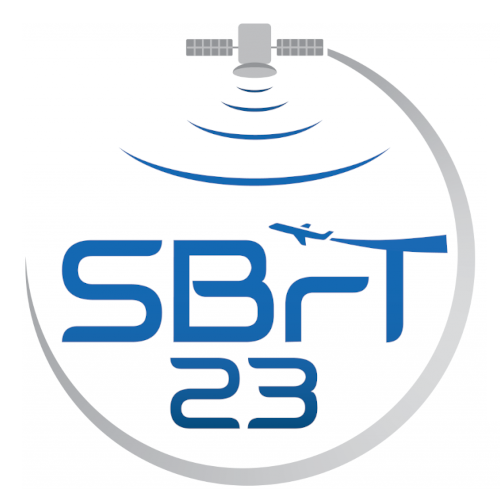
XLI Simpósio Brasileiro de Telecomunicações e Processamento de Sinais
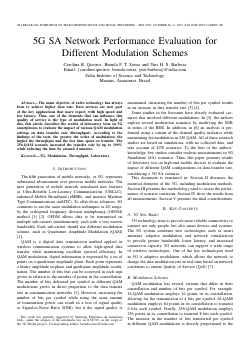
5G SA Network Performance Evaluation for Different Modulation Schemes
Brenda Sousa, Yuri hernan Santos Barbosa, Carolina Ribeiro Queiroz
DOI: 10.14209/sbrt.2023.1570907918
Keywords: 5G Modulation Throughput Laboratory
Abstract
The main objective of radio technology has always been to achieve higher data rates. Data services are now part of the key applications that users expect, with high speed and low latency. Thus, one of the elements that can influence this quality of service is the type of modulation used. In light of this, this article describes the results of laboratory tests on 5G smartphones to evaluate the impact of various QAM modulation settings on data transfer rate (throughput). According to the findings of the tests, the greater the order of modulation, the higher the throughput and the less time spent on transfer. The 256-QAM scenario increased the transfer rate by up to 190% while reducing the time by around 4 minutes.Download

Avaliação de Desempenho de Redes de Sensores Corporais Sem-Fio com Mobilidade Usando Protocolo de Roteamento AODV
Creyton Ferreira, Raphael M. Guedes, Laura de Assis, Diego Haddad, Felipe da Rocha Henriques
DOI: 10.14209/sbrt.2023.1570907955
Keywords: WBAN Mobilidade AODV
Abstract
Redes de Sensores Corporais Sem-Fio (do inglês, Wireless Body Area Networks - WBANs) com suporte à mobilidade estão sujeitas a desconexões devido a variações posturais, típicas do movimento humano. Neste cenário, este trabalho analisa o comportamento do protocolo de vetor distância AODV para roteamento em WBANs com mobilidade. Nós avaliamos dois padrões distintos de movimento, para ambos os padrões de rede sem-fio, IEEE 802.15.4 e IEEE 802.15.6. O primeiro padrão de movimento é fornecido pelo simulador de rede Castalia; e o segundo padrão de movimento é implementado usando o modelo MoBAN, que gera um padrão de movimento mais realista, típico de posturas humanas. Os resultados obtidos mostram que o padrão de rede IEEE 802.15.6 é superior ao padrão IEEE 802.15.4, em cenários com mobilidade, tanto em relação à taxa de perdas, quanto em relação ao consumo de energia.Download

Detecção de Placas Veiculares em Ambientes Aéreos utilizando Super Resolução por GAN e Equalização de Histograma
José Elislande Breno de Souza Linhares, Waldir Silva, Frederico da Silva Pinagé, Wheidima Melo, Georgio S. Colares, Luiz Carlos da Silva Garcia Junior, Anderson de Jesus, Newton Pinheiro Bitar, Andrey Ruben Ribeiro Bessa, Gabriel Araujo
DOI: 10.14209/sbrt.2023.1570908005
Keywords: Imagens aéreas Detecção de placas veiculares Super resolução Equalização de histograma
Abstract
Neste artigo, propõe-se uma metodologia para detecção de placas veiculares em ambientes aéreos, onde o objeto de interesse apresenta baixa resolução em pixel em relação à imagem de entrada. A metodologia proposta é composta por três sistemas distintos. Duas utilizam técnicas de melhoria de qualidade da imagem e uma não as utiliza. Ao analisar os resultados por grupo de imagens, observa-se que o sistema proposto com equalização de histograma apresenta os melhores resultados com acurácia de até 85,67% em condições adversas ensolaradas e 99,33% em condições adversas sombreadas.Download

Análise pelo Método dos Elementos Finitos do Efeito da Polarização em Problemas de Radiação em Regiões Mistas de Rios e Florestas
Alexandre Oliveira, Karlo Queiroz Costa
DOI: 10.14209/sbrt.2023.1570908017
Keywords: finite elements method horizontal polarization vertical polarization propagation of electromagnetic waves
Abstract
This article shows the results obtained using computational simulation with the computer software Comsol MultiPhysics to visualize the propagation of the electrical and magnetic fields for the cases of vertical and horizontal polarization. The study modeled a medium more similar to the Amazon region.Download
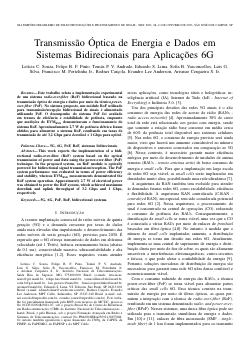
Transmissão Óptica de Energia e Dados em Sistemas Bidirecionais para Aplicações 6G
Letícia Carneiro Souza, Felipe Batista Faro Pinto, Tomas P V Andrade, Eduardo Saia, Sofia Balerini de Vasconcellos, Luis Da silva, Francisco Portelinha, Rodnei Carçola, Evandro Lee Anderson, Arismar Cerqueira Sodre Jr.
DOI: 10.14209/sbrt.2023.1570908221
Keywords: 5G 6G PoF RoF
Abstract
This work reports the implementation of a bidirectional radio-over-fiber (RoF) system based on the optical transmission of power and data using the power-over-fiber (PoF) technique. In the proposed system, an RoF module is optically powered for bidirectional signal transmission/reception. The PoF system performance was evaluated in terms of power efficiency and stability, whereas EVMrms measurements demonstrated the RoF system operation. Approximately 2.7 W of electrical power was obtained to power the RoF system, which achieved maximum downlink and uplink throughput of 3.2 Gbps and 1 Gbps, respectively.Download

Continuous and Discrete Phase-shifts for RIS-aided Systems in Wideband Communication Channels
Pedro Henrique Carneiro Souza, Masoud Khazaee, Luciano Leonel Mendes
DOI: 10.14209/sbrt.2023.1570908239
Keywords: RIS wideband discrete phase-shifts quantization
Abstract
This work investigates the performance of the reconfigurable intelligent surface (RIS) for wideband communication systems, also considering line of sight (LOS) channels. We evaluate the achievable rate of methods such as the alternating optimization (AO) and strongest tap maximization (STM), which are used to configure the RIS. Additionally, the impact of continuous and discrete phase-shifts is also analyzed in the context of novel proposed metrics, denoted as the relative and efficiency rate. It is demonstrated that discrete or quantized phase-shifts can achieve a rate close to that of continuous phase-shifts, if enough quantization bits are used.Download
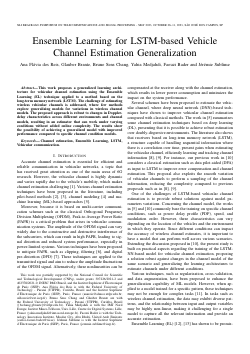
Ensemble Learning for LSTM-based Vehicle Channel Estimation Generalization
Ana Flávia Reis, Bruno Chang, Glauber Brante, Yahia Medjahdi, Faouzi Bader, Jérémie Sublime
DOI: 10.14209/sbrt.2023.1570908283
Keywords: Channel estimation Ensemble Learning LSTM Vehicular communication
Abstract
This work proposes a generalized learning architecture for vehicular channel estimation using the Ensemble Learning (EL) technique applied to a method based on the long-term memory network (LSTM). The challenge of estimating wireless vehicular channels is addressed, where few methods explore generalizing models for variations in wireless channel models. The proposed approach is robust to changes in Doppler-delay characteristics across different environments and channel models, resulting in an estimator that can work under varying conditions without added online complexity. The results show the possibility of achieving a generalized model with improved performance compared to specific channel condition models.Download

Artificial Noise for In-Home and Broadband PLC Systems: An Initial Discussion
Gustavo M Campos, Pedro Henrique Sartorello, Mateus Filomeno, Ândrei Camponogara, Moises Vidal Ribeiro
DOI: 10.14209/sbrt.2023.1570908329
Keywords: artificial noise physical layer security power line communication
Abstract
This paper discusses improvements in the information security of in-home and broadband power line communication systems. To achieve this, we introduce artificial noise, designed based on the degrees of freedom of the cyclic prefix, for impairing the eavesdropper's decoding capacity without adversely affecting the legitimate receiver. Numerical outcomes derived from measured data indicate that the artificial noise is more effective in jamming when the eavesdropper is closer to the legitimate transmitter.Download
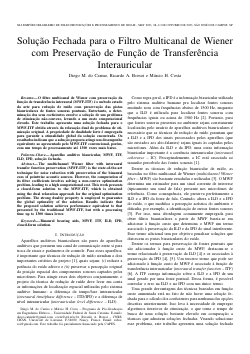
Solução Fechada para o Filtro Multicanal de Wiener com Preservação de Função de Transferência Interauricular
Diego Marques do Carmo, Ricardo Augusto Borsoi, Marcio H Costa
DOI: 10.14209/sbrt.2023.1570908338
Keywords: Aparelho auditivo biauricular MWF ITF Solução Fechada
Abstract
O filtro multicanal de Wiener com preservação da função de transferência interaural (MWF-ITF) é o método estado da arte para redução de ruído com preservação das pistas biauriculares de fontes sonoras pontuais. Entretanto, a determinação dos seus coeficientes envolve a solução de um problema de otimização não-convexo, levando a um custo computacional elevado. Este trabalho apresenta uma solução fechada para o MWF-ITF obtida através da relaxação dual do problema de otimização original. A propriedade de dualidade forte é empregada para garantir a otimalidade global da solução encontrada. Os resultados indicam que a solução proposta atinge um desempenho equivalente ao apresentado pelo MWF-ITF convencional, porém, com um tempo de processamento até 1300 vezes mais baixo.Download
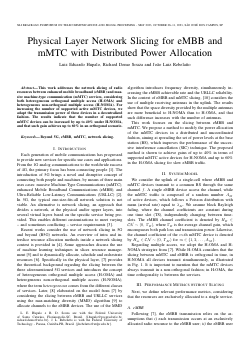
Physical Layer Network Slicing for eMBB and mMTC with Distributed Power Allocation
Luiz Eduardo Hupalo, Richard Demo Souza, João Luiz Rebelatto
DOI: 10.14209/sbrt.2023.1570908339
Keywords: Beyond 5G eMBB mMTC Network slicing
Abstract
This work addresses the network slicing of radio resources between enhanced mobile broadband (eMBB) and massive machine-type communication (mMTC) services, considering both heterogeneous orthogonal multiple access (H-OMA) and heterogeneous non-orthogonal multiple access (H-NOMA). For increasing the number of supported active mMTC devices, we adapt the transmission power of these devices in a decentralized fashion. The results indicate that the number of supported mMTC devices can be increased by up to 40% under H-NOMA, and that such gain achieves up to 60% in an orthogonal scenario.Download